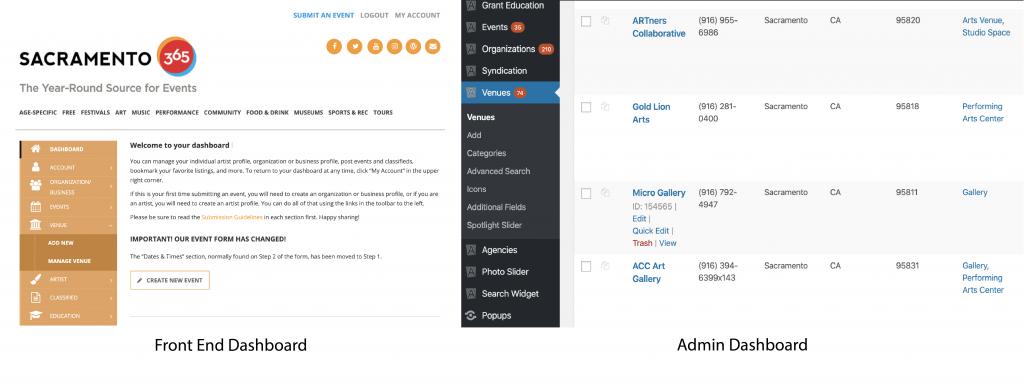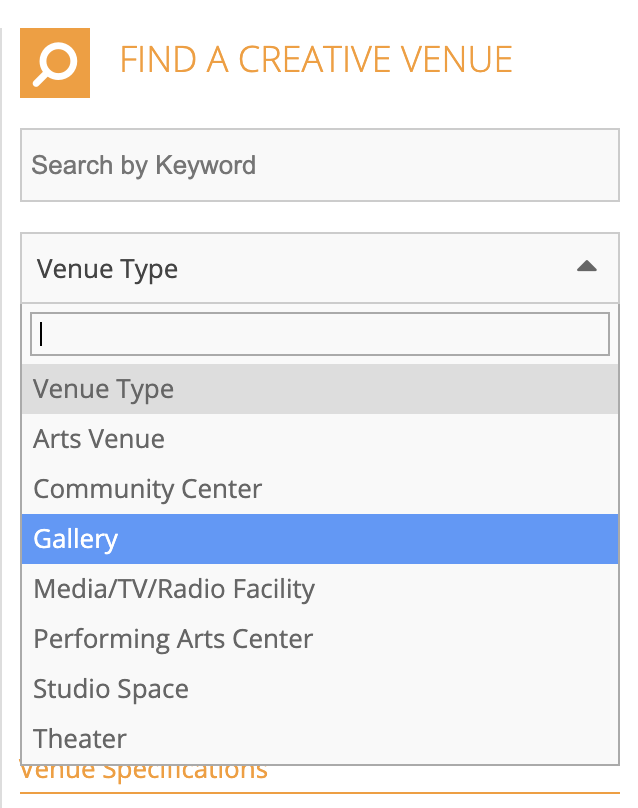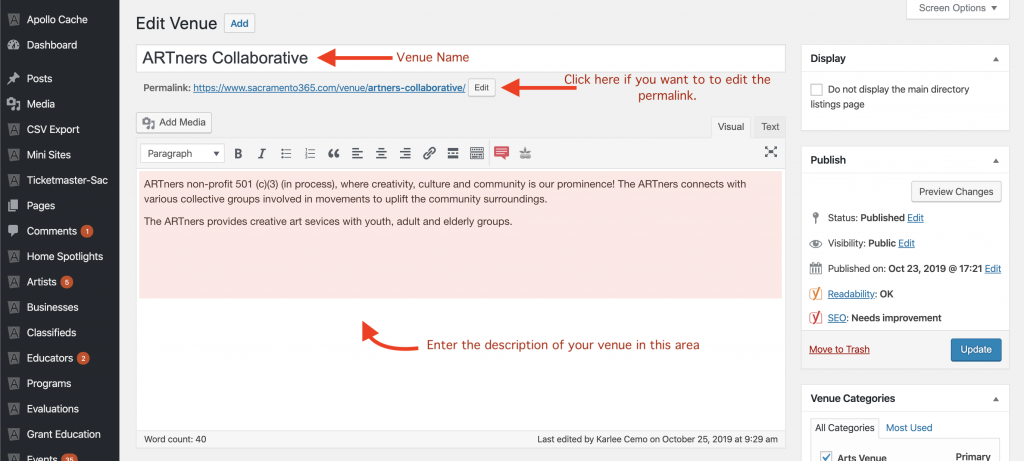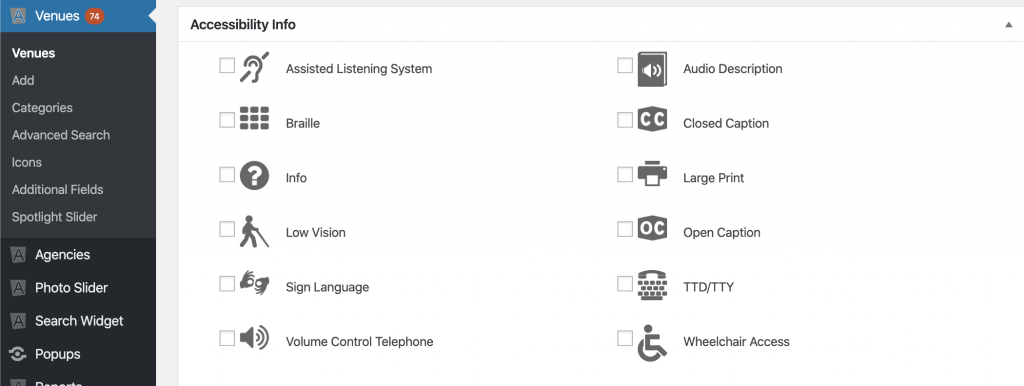The Venue Directory module provides an enhanced listing of registered venues available for searching or browsing. The module operates in conjunction with the Event Calendar module and supports an unlimited number of registered venues.
Venue Directory listings can be managed from both the ‘front end’ user dashboard (by representatives of the venue) and administrative control panel. All initial submissions require approval by the website’s content administrator, though subsequent edits by front end users can be set to bypass the administrative review process.

An unlimited number of venue categories (and sub-categories) can be added, allowing users to filter lists by such categories as “community center”, “concert hall”, “library”, “museum”, “performing arts center”, “school”, “theater” and so on.

The Venue Directory module also allows you to create a ‘parent – child’ relationship between various listings, such as a performing arts center or university that has multiple venue locations that all fall under one master location. This allows your visitors to look for events at specific locations or at all events covering all locations.
For example, Stanford University (the “parent” listing) has several venues on campus where events take place. They can set up individual listings for each location, as well as a master listing representing the entire school. A visitor can then select Cantor Museum, Memorial Church or Stanford Stadium (the “child” listings) to see what events might be taking place at those specific locations, or they can go to Stanford University’s “parent” venue page to see all events happening on campus.
Admin Dashboard & Profile Main Form Functions
Title/Venue Name – The name of the venue. Use the most common name of the venue. You can include the full name or alternative name of the venue in the description. WordPress will generate a user-friendly and URL-valid name of the venue (also called the “slug”) to compose the permalink for the venue.
Permalink – Our system automatically generates a slug and displays it as the org URL just below the venue title. You can edit the URL slug by clicking on the edit link below the post title.
Venue Description – The blank box where you enter the venue description, links, and any information you want to display on your site. You can use either the Visual or the Text view to compose your posts. Visual Editor is a beginner friendly text editor with formatting buttons and a nice visual layout for content area. On the other hand, text editor is a plain text editor where you can actually see the HTML or write your own. A word count is provided at the bottom of the description field as well as the autosave status.

Address Information – Venue address including street address, state, city, and zip code. This information is displayed publicly.
Venue Data – Phone number, fax number, email address, plus parking information, public hours, and admission details. This information is displayed publicly.
Website & Social Media URLs – Includes URL fields for the organization’s official website, blog, donation page, plus social media platforms including Facebook, Twitter, Instagram, Pinterest, and LinkedIn.
Venue Video – The org form accepts video share links provided by YouTube, Vimeo and Brightcove. A video added to this form will appear on venue detail page.
Contact Info – Name, email and phone number of the venue contact. This information does not appear on the front end venue detail page and is only used for administrative purposes.
Accessibility Information – Checklist of accessibility accommodations provided by the venue.

Rental Space Information – If the venue us available for rent, this section offers the opportunity to list its features like rental price range, type of space, set up options, seating capacity, technology, and the venue’s approved uses.
Icons – This sections offers the opportunity to place linked logos or small images representing an association between a venue and an organization, artist or other venues, ideal for cross promotion.
Admin Dashboard Right Column
Publish Box – Contains buttons that control the state of your venue profile. The main states are Published, Pending Review and Draft.

- Save Draft button stores a draft of the profile that you are working on. WordPress also auto-saves your profiles as you write them.
- ‘Preview Changes’ button shows a live preview of your profile. You can use it to see how your profile will look after publishing.
- Status allows you to set a status for your post. WordPress automatically handles post status for drafts and published posts. Unless you are using a plugin to add custom statuses, you don’t need to worry about this option.
- Visibility has three option: public, password protected, and private. These options are for blogging; you don’t need to worry about them.
- Click on the ‘edit’ link next to ‘Status: Publish’, and WordPress will display the publishing options. If you ever need to revert a profile from Published back to Pending status, this is where you would do that.
- ‘Move to Trash’ allows you to delete an event listing. Deleted events live under Trash, and you can restore them if you need to for up to 30 days.
- Finally, the ‘Publish’ button makes your event listing public. Once an event is publish, the blue button will read ‘Update’. Any changes that need to be made to the profile will appear once you’ve entered them and clicked the ‘Update’ button.

Venue Category – A list of venue types available when registering a venue (or updating a venue record). Use this list as a reference to best match to the venue’s activities. Multiple category selection is available.
Venue Gallery – Multiple images may be uploaded along with the event’s Featured image. These images will display on the venue page in the Gallery area.
Featured Image – The Featured image is the primary image that will be displayed on the site. Simply click on set featured image link, and it will bring up the media uploader popup. You can select an image from your previous uploads or upload a new image from your computer.
Associated User – This shows which user profiles are associated with your venue. You can associate more than one use with a venue profile. Ask you site administrator for help if you would like to do this.
Altering Screen Options
Some of the options on the event form are hidden by default to present a cleaner and simpler editing experience. These options are not commonly used by beginners. However, you may need them later. Simply click on the Screen Options button on the top right corner of the page. This will show a menu with checkboxes next to option names.

As you can see most of the options will already be checked. For the others, you can display them by clicking on the checkbox next to an option name, and it will appear on your page.
Visual Versus Text Editor Toolbar
When writing your post, you have the option of using the Visual or Text mode of the editor. The Visual mode lets you see your post as is and format using the WYSIWYG toolbar.

Functions include:
- Bold – Turns selected text into bold text.
- Italics – Turns selected text into italicized text.
- Strikethrough – Turns selected text into
strikethrough text. - Bulleted list – Turns the selected text into an bulleted list.
- Numbered list – Turns the selected text into a numbered list.
- Blockquote – Blockquote is a block-level element that can be used to set-off quotations or to cite material.
- Horizontal line – Adds a horizontal rule.
- Align left – Moves all selected text to the left.
- Align center – Centers all selected text.
- Align right – Moves all selected text to the right.
- Add/edit link – To create a hyperlink, select the text or image for the link, then click on the Add/Edit Link icon and paste the target URL. For links external to the site, click the “gear” icon to open the link options and check the “Open link in a new tab” checkbox. Click the Add Link button to insert the hyperlink just created. Click Cancel to close the window and return to the editor.
- Remove link – Select the hyperlink and click on the Remove Link icon to remove a hyperlink.
- Insert read more tag – For blogging only. Allows you truncate your blog posts so you can display a post excerpt on your main pages.
- Toolbar toggle – Enables the second row of editing icons.
- Underline – Turns selected text into underlined text. Please note that underlined text usually means that a word or phrase is a link to another web page. In this case however, the underline formatting does not create a link (to create a link, see the Insert/Edit Link icon).
- Justify – Justifies text making it flush on both the left and right sides.
- Font color – This icon sets the color of any selected text. To start typing new text with a specific font color, click on the cursor at the location where new text is to be inserted, select a color from the drop-down list, then begin typing.
- Background color – This icon sets the background color of any selected text.
- Clear formatting – To remove all formatting for a selection, highlight the text to be updated and click on the Clear Formatting icon. This returns the selected text back to the default settings.
- Special character – To insert a special character such as an copyright symbol, registered trademark, or other symbol, click the Insert Special Character icon. The Special Character modal provides a selection of 200 special characters from which to choose. Hover or use the left and right keyboard arrows to navigate the selection. Clicking a character will add it to the page and close the modal.
- Decrease indent – To decrease the indent of a paragraph, click on the Decrease Indent icon. Each consecutive click will move text further to the left.
- Increase indent – To increase the indent of a paragraph, click on the Increase Indent icon. Each consecutive click will move text further to the right.
- Undo – Click on the Undo icon to undo the last changes made in this session one-by-one.
- Redo – Click on the Redo icon to redo changes that were just undone and should be restored.
- Keyboard shortcuts
The Text mode shows you the code and replaces the WYSIWYG editor buttons with quicktags.

These quicktags are explained as follows.
- b – <strong></strong> HTML tag for strong emphasis of text (i.e. bold).
- i – <em></em> HTML tag for emphasis of text (i.e. italicize).
- link – <a href=”http://example.com”></a> HTML tag to create a hyperlink.
- b-quote – <blockquote></blockquote> HTML tag to distinguish quoted or cited text.
- del – <del></del> HTML tag to label text considered deleted from a post. Most browsers display as striked through text.
- ins – <ins></ins> HTML tag to label text considered inserted into a post. Most browsers display as underlined text.
- ul – <ul></ul> HTML tag will insert an unordered list, or wrap the selected text in same. An unordered list will typically be a bulleted list of items.
- ol – <ol></ol> HTML tag will insert a numbered list, or wrap the selected text in same. Each item in an ordered list is typically numbered.
- li – <li></li> HTML tag will insert or make the selected text a list item. Used in conjunction with the ul or ol tag.
- code – <code></code> HTML tag for preformatted styling of text. Generally sets text in a monospaced font, such as Courier.
- more – <!–more–> WordPress tag that breaks a post into “teaser” and content sections. Type a few paragraphs, insert this tag, then compose the rest of your post. On your blog’s home page you’ll see only those first paragraphs with a hyperlink ((more…)), which when followed displays the rest of the post’s content.
- close tags – Closes any open HTML tags left open–but pay attention to the closing tags. WordPress is not a mind reader (!), so make sure the tags enclose what you want, and in the proper way.
Questions or suggestions? Contact: networksupport@artsopolis.com
